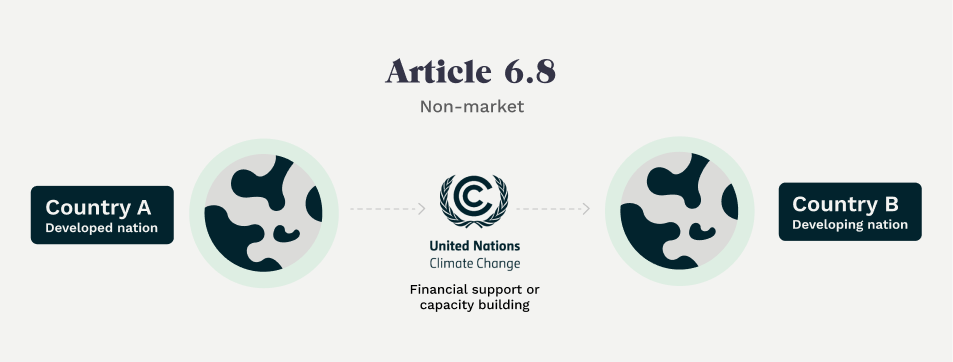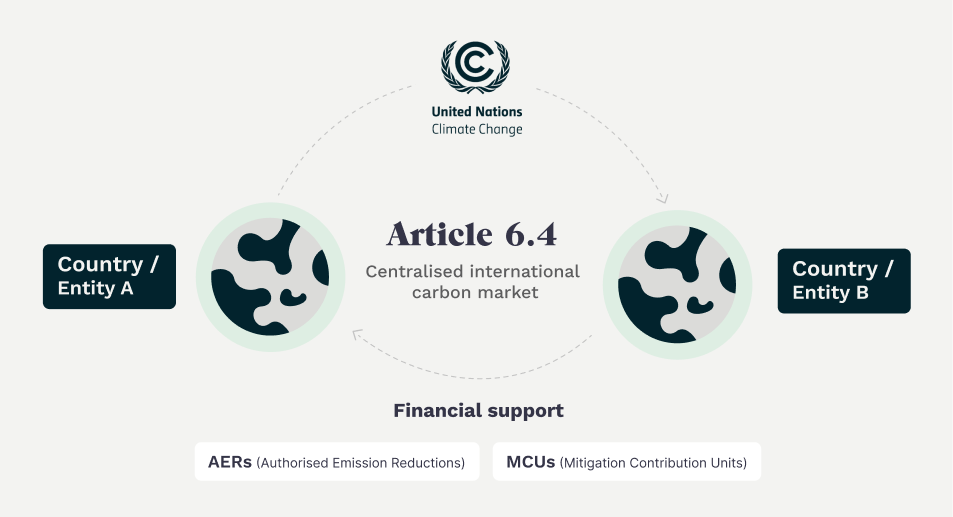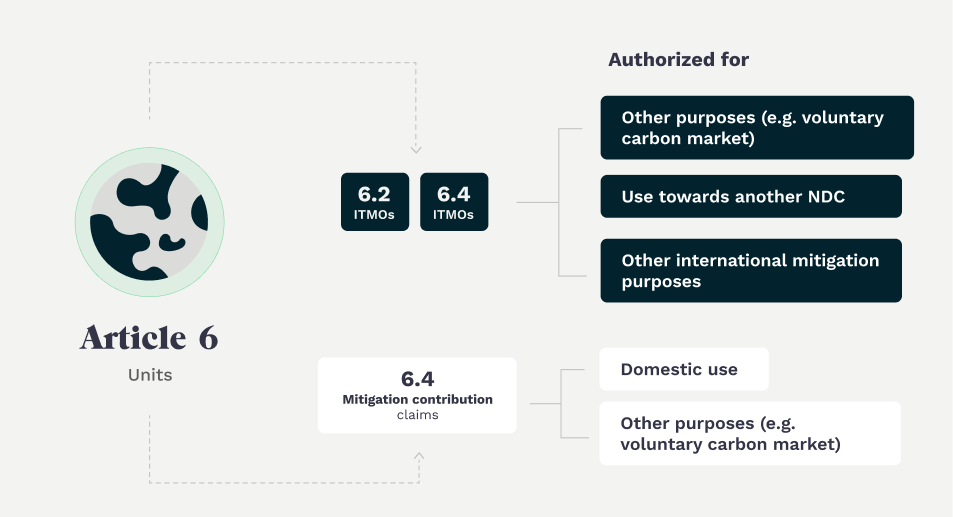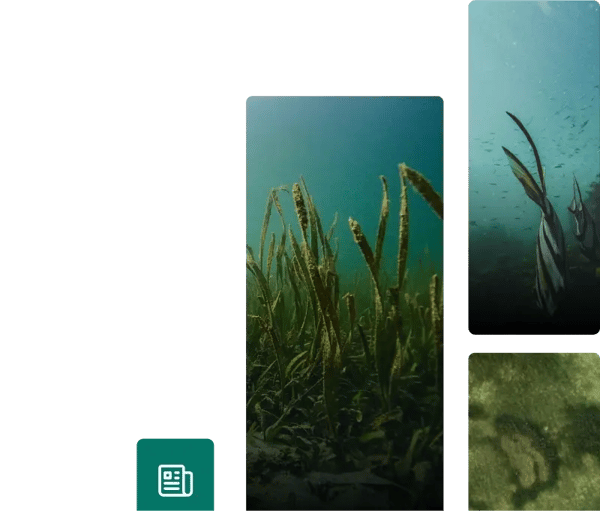In the race against climate change, countries have come together and developed many mechanisms over the years in order to help establish how countries can reach their climate goals. Article 6 of the Paris Agreement was one of them, and the highly anticipated COP28 negotiations around this mechanism proved disappointing.
Understanding Article 6: What Is It?
Article 6 was a key part of the Paris Agreement during COP26 in 2021, however negotiations are still ongoing concerning how best to operationalise it. Article 6 covers both market-based approaches (Article 6.2 and Article 6.4) and non-market approaches (Article 6.8).
In general, Article 6 of the Paris Agreement acknowledges that countries can pursue voluntary cooperation in the implementation of their Nationally Determined Contributions, or NDCs, (“a climate action plan to cut emissions and adapt to climate impacts”) to allow for higher mitigation ambition and to promote sustainable development. When it was time to discuss these negotiations at COP28, it ended with no agreed-on conclusion for how Article 6 should function.
Examples of how countries can work together in this Article 6 mechanism:

Article 6.2 (country-to-country carbon trading)
Country A (host country) is on track to exceed its NDC target, while Country B (buyer country) is having trouble meeting theirs. Country A can sell this surplus to Country B in the form of ITMOs, or “Internationally Transferred Mitigation Outcomes” units, that would provide Country A with resources not available domestically.
Article 6.4 (centralised international carbon market)
Both public and private actors alike can participate in countries’ carbon reduction efforts through the act of carbon project financing. Entity A or Country A (project host) generates carbon credits through a project financed by another country or entity. The carbon credit units (A6.4ERs) are approved through a UNFCCC centralised mechanism and overseen by a United Nations entity. The issued A6.4ERs come in 2 types: Authorised Emission Reductions (AERs) and non-authorised emission reductions, also known as Mitigation Contribution Units (MCUs).
Article 6.8 (non-market)
International cooperation and knowledge transfer is at the centre of this approach. Country A (developed nation) decides to support Country B (developing nation) by sharing financial or technical resources to their climate mitigation projects via a UNFCCC centralised website without the expectation of trading carbon credit units.
Countries have not agreed upon how they want these Article 6 carbon markets to be. Some countries want these markets made available with little to no restrictions, while other countries insist that these markets promote transparency, human rights and climate ambition. Due to this divide, the subject of Article 6 at COP28 proved to be a tedious one and no draft texts have been accepted.

COP28 takeways
Article 6.2: COP28 Takeaways
Before coming into COP28, there were several countries that created bilateral deals for Article 6.2, therefore intensive talks were held to understand the arrangements and rules countries would have in order to report on their current and future trades.
After two weeks of talks, no deal was reached, leaving the carbon market in a state of uncertainty. This means that no rules were agreed upon that would help avoid greenwashing and questionable trading. In fact, the final draft text that came out of COP28 did not enforce limits on the amount of information countries could deem “confidential”.
Without an agreement on the reporting, crediting authorisation rules, and a common transparency definition, agreements under 6.2 will continue without guidance as there is no UN oversight. The lack of strict rules leaves the current bilateral deals unsure of what the future holds. Countries that have existing deals to purchase carbon credits under Article 6.2, such as Switzerland, Japan and Singapore, have to now anticipate that future rules may disturb these trades.
Overall, the new draft text did not define common objectives, therefore countries can move forward with their own interpretations of this Article.
Article 6.4: COP28 Takeaways
As this Article is set to replace the Clean Development Mechanism (CDM) next year, negotiations at COP28 were heavily watched. Article 6.4 embraces a centralised credit mechanism for countries that cannot operate under Article 6.2, or want another avenue to explore. How it will differ from the CDM is that it will include two types of A6.4ER contributions: AERs for ITMOs not counted towards the host country’s NDC, and MCUs that do not require a corresponding adjustment (private companies can therefore use these credits to contribute towards the host country’s NDC whilst making a climate contribution claim).
In order for carbon project developers to participate in this Article, they would need approval from host countries before they apply to the UN Supervisory Body, the actor who oversees this new credit system and centralised mechanism. When the carbon project developer gets approval, they receive A6.4ERs. As this new mechanism is under development, the UN Supervisory Body presented its guideline recommendations at COP28.
A big topic of discussion was the type of projects eligible to be under this Article and how to define the amount of credits each project can generate. The baseline, against which carbon emission reductions/removals can be credited, has to be consistent with the host country’s own climate pledged goals. This is different from it being set against a “business-as-usual” baseline. The UN Supervisory Body has not yet developed the tool to avoid carbon leakage or additionality questions. Meaning that without an agreed upon approach, the trading of A6.4ERs will not likely happen in the near future as the system, tools and registry are not yet developed.
Final Thoughts
This year, COP29 will be held in Baku, Azerbaijan, and it will be the next change for countries to reach a conclusion on the operational side of Article 6. We are now eagerly waiting for the latest minutes from the 10th UN Supervisory Body Meeting that concluded March 1st, 2024.
While we wait for a more final outcome of the UNFCCC centralised carbon mechanism, the opportunities that the voluntary carbon market offers will remain key. At ClimateSeed, we build strong relationships with project carriers that implement projects recognised in the Voluntary Carbon Market to offer our clients high-quality carbon reduction and removal projects. Discover more here.
Sources
https://carbonmarketwatch.org/2023/12/13/cop28-article-6-failure-avoids-a-worse-outcome/
https://fsr.eui.eu/cop28-and-international-carbon-markets-what-to-expect/
https://co2-iq.com/en/carbon-markets-at-cop28
https://www.carbonbrief.org/cop28-key-outcomes-agreed-at-the-un-climate-talks-in-dubai/
https://www.ecosystemmarketplace.com/articles/what-lies-ahead-for-carbon-markets-after-cop28/
https://www.nature.org/content/dam/tnc/nature/en/documents/TNC_Article_6_Explainer_260523.pdf
https://www.smithschool.ox.ac.uk/news/article-6-focus-outcomes-cop28
https://globalforestcoalition.org/wp-content/uploads/2022/11/Briefing-Article-6.pdf
https://www.woodmac.com/news/opinion/cop28-article-6/
Share this
You May Also Like
These Related Stories

Understanding Blue Carbon & Mangroves' Role in Carbon Sequestration

COP28 Climate Summit to Kick-off in Dubai
%201.png)



